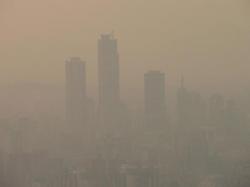 I can only imagine the fear that must grip a parent when their child suffers an asthma attack, and I can only imagine how much time and energy they spend doing everything they can to avoid triggers for these potentially deadly attacks. A major trigger is smog pollution – also known as ground-level ozone. When smog is inhaled, the harm it does has been likened to getting a sunburn on your lungs, and these asthma attacks send tens of thousands of kids to the emergency room every year. Kids and seniors are especially at risk from smog pollution.
I can only imagine the fear that must grip a parent when their child suffers an asthma attack, and I can only imagine how much time and energy they spend doing everything they can to avoid triggers for these potentially deadly attacks. A major trigger is smog pollution – also known as ground-level ozone. When smog is inhaled, the harm it does has been likened to getting a sunburn on your lungs, and these asthma attacks send tens of thousands of kids to the emergency room every year. Kids and seniors are especially at risk from smog pollution.
This is why the Sierra Club is so adamant in urging the Clean Air Scientific Advisory Committee, which provides independent advice to the Environmental Protection Agency, to recommend a strong, science-based standard to protect Americans from smog (you can read our comments right here – PDF) Right now the EPA is updating the country’s smog pollution limits as required by the Clean Air Act.
Asthma is the number one health problem that causes American children to miss school, and it costs taxpayers tens of billions of dollars each year in missed work and health care costs. Research has shown that exposure to smog causes respiratory problems including asthma, may affect the nervous and cardiovascular systems, and can lead to premature death.
As the proud mom of a busy, active three-year-old, it’s hard for me to imagine keeping her inside on a beautiful summer day. But that’s exactly what parents of kids with asthma must do, all too often. Those parents, kids, seniors and people with chronic respiratory ailments know what it’s like to learn that your day will be cut short by an Orange, Red or even Purple Air Quality Alert.
When smog hits these levels, those people are stuck inside waiting for outdoor air quality to return to safe levels for them to breathe. One needs to look no further than the American Lung Association’s annual “State of the Air” reports to see the cities where bad air days are most frequent — days that air quality is so poor that being outdoors could kill them.
With the technology readily available to dramatically reduce smog, it would be unconscionable not to act. We need standards that reflect the latest science. For example, in Pittsburgh, coal plants are the single biggest contributor to smog pollution, but those facilities could cut that pollution by more than a third just by operating the pollution controls that the plants already have. They could cut it even further by installing modern controls!
The American people should not have to wait any longer for action to clean up dangerous smog pollution. It’s time to clean up our air and protect our families. Join us – tell the EPA to finalize strong protections on smog pollution.


